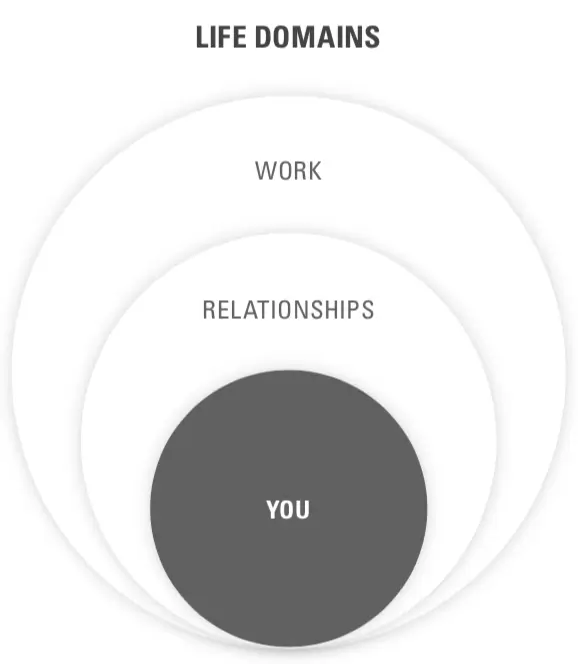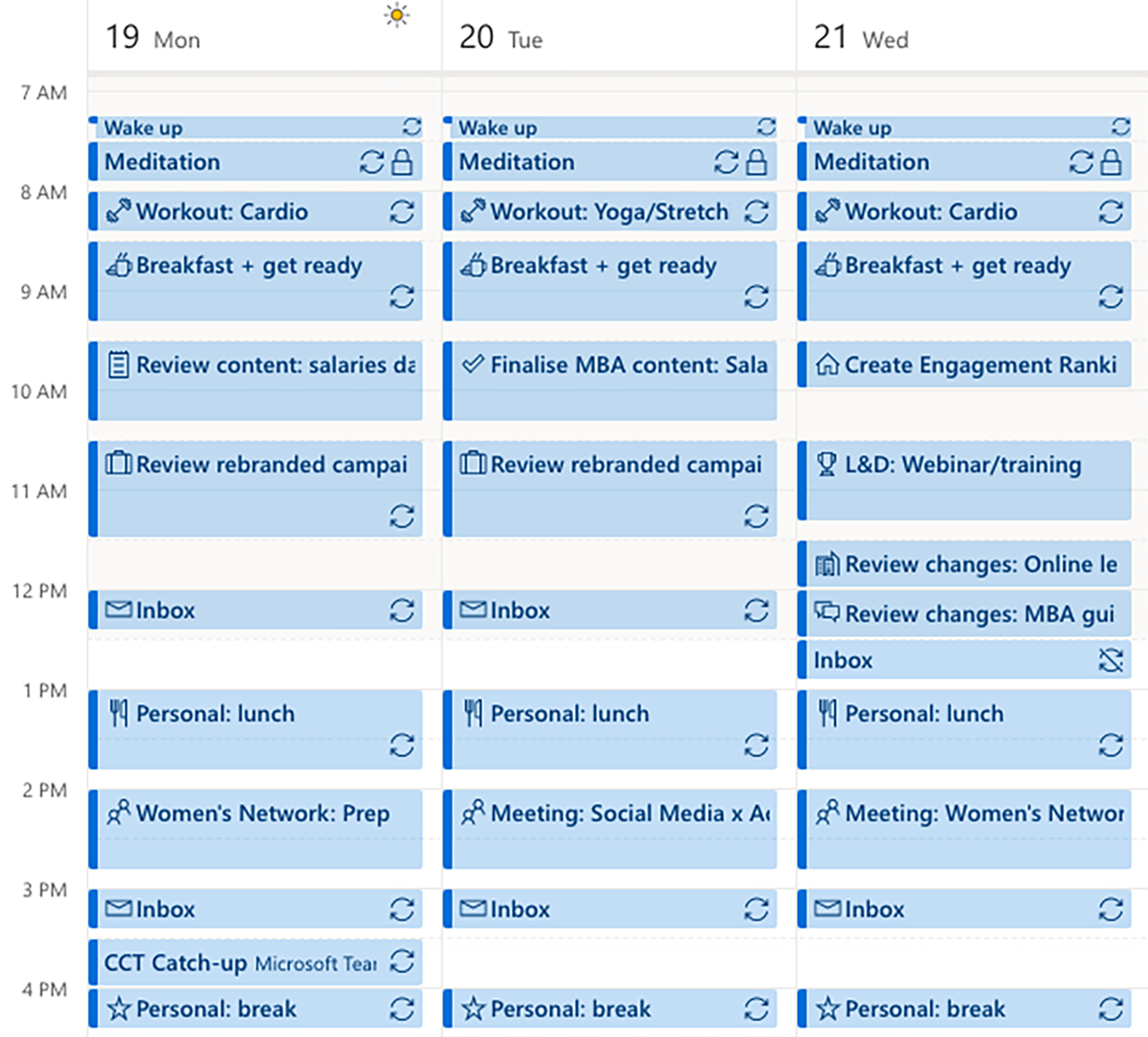A Step-by-Step Guide to Timeboxing, With Examples
Timeboxing is the most powerful time-management technique. However, there is no one way to timebox. Some people keep the same schedule every week and review it on Sundays. Others change their timeboxed calendar daily and review it the night before.
Some people use a spreadsheet in 30 or 15-minute increments (get my free schedule maker here), others use Google Calendar, and others use one of the many timeboxing apps available.
This step-by-step guide, plus timeboxing examples from real people, will help you figure out what timeboxing looks like for you.
Remember: No productivity technique is effective and easy. It’s going to be effective and hard. Nothing will magically solve time management without some effort.
Step One: Identify Your Values
According to Russ Harris, author of The Happiness Trap, values are “how we want to be, what we want to stand for, and how we want to relate to the world around us.”
Values are attributes of the person we want to be.
For example, your values may include being an honest person, being a loving parent, or being an appreciated part of a team. We never achieve our values any more than finishing a painting would let us achieve being creative. A value is like a guiding star; it’s the fixed point we use to help us navigate our life choices.
Categorize those values into the three life domains below to build an authentic, holistic image of the person you want to be.

Step Two: Turn Your Values into Time
Decide how much time you need to spend on each life domain to be consistent with your values.
List the activities and tasks that exercise your values, which I call “traction.” These are the activities that you will plot into your weekly timeboxed calendar.
To meet your value of being healthy, perhaps you’ll pick activities like a workout class or meal planning. To exercise the relationship value of being a good life partner, schedule regular date nights to give the two of you time for deep conversations. To practice the value of playfulness, list activities like time to play video games, a game night with friends, or playtime with your kids.
Notice that timeboxing isn’t just about “getting things done.” It’s about being the kind of person you want to become. If the kind of person you want to become enjoys an hour of playing video games or scrolling social media, great! Do it! But do it according to your schedule and your values.
Step Three: Create a Timeboxed Calendar
Create a calendar template for your perfect week, guided by how much time you’ve decided to spend on each life domain. Schedule the activities you listed in the previous step.
A quick side note on the planning fallacy: Humans tend to be overly optimistic about how long tasks take. One study found that even when forced to consider the worst-case scenario for the time a task would take, participants regularly disregarded it in favor of the best-case scenario. We can’t help but try and pack as much as we can into each day! But that sets us up for failure before we even begin.
Say you’re going to the gym for a 45-minute workout. You’re not timeboxing just 45 minutes; you’re also timeboxing the time it takes to get there and back, plus the time you need to shower, get dressed, and eat something. So you might be talking about two hours!
A trick for avoiding the planning fallacy is to triple the time you estimate a task will take, especially for work-related tasks with strict deadlines.
Step Four: Track How Well You Follow the Calendar
Inevitably, three things will get in the way of your timeboxed calendar. There are only three possible causes of any distraction (click on a link below to learn more about each):
To prevent those three distractions in the future, you’ll need to identify the source.
As Paulo Coelho said, “A mistake repeated more than once is a decision.”
If you keep getting distracted by the same things again and again without putting practices in place to prevent them from happening in the future, you are deciding to be distractible.
I recommend using my free distraction tracker to note:
- The time you went off-track
- The source of the distraction (either an internal trigger, external trigger, or a planning problem)
- Ideas for how to overcome the distraction next time
Step Five: Reflect and Refine
Timeboxing is a long-term experiment. You should schedule 15 minutes every week to review and refine your calendar.
First, ask yourself, “When in my schedule did I do what I said I would do, and when did I get distracted?”
If an internal trigger distracts you, what strategies will you use to cope the next time it arises? If it was an external trigger, like a phone call or a talkative colleague, how can you prevent that kind of interruption in the future?
If a planning problem was the reason you gave in to distraction, ask yourself, “Are there changes I can make to my calendar that will give me the time I need to better live out my values?” For example, if the planning problem was an unexpected event, was it a one-time interruption or something that may happen again? If the latter, what contingency plan can you put in place?
It may take several weeks of repeating Steps 2 through 5 before you land one that suits you. Even then, if you experience changes in your environment or life circumstances, such as moving homes or starting a new job, you’ll likely have to adjust your timeboxed calendar.
Tips for Timeboxing Newbies
Start with “you” time. You need time in your schedules for rest, intellectual enrichment, proper nourishment, prayer, or whatever else helps you live out your values. By setting aside time to live out your values in the “you” domain, you will have the time to reflect on your calendar and visualize the qualities of the person you want to be. With your body and mind strong, you will also be much more likely to follow through on your other commitments.
Schedule fun stuff! Many people make the mistake of thinking everything on their calendar should be productivity-focused. Quite the opposite! To see the real power of timeboxing, start by building your perfect day.
When you use timeboxing to schedule activities you want to do—even if they include watching TV or playing video games—you’ll see just how you really can do anything you want to do, just not all at once. You’ll enjoy those activities more without feeling guilty.
Give yourself options. Some think preplanning exactly what they will do is too constraining. But timeboxing offers structure with room to play. You don’t have to schedule a specific activity, like “wash the dishes.” You can schedule a broader category.
For example, I timebox “admin” every week and keep an ongoing list of admin tasks, like “pay this bill” or “schedule a dentist appointment.” When the admin time comes around, I can choose any task. My daughter and I used to schedule time for “planned spontaneity.” Every week at the same time, we picked an activity from a “fun jar” together.
You can timebox exercise, chores, independent learning, and fun with friends without scheduling a precise activity. How do you know whether the category is too broad? As long as it’s specific enough so that you know what you will not be doing at that time, it’s niche enough.
Know what a crisis is (and is not). A crisis is an unexpected event requiring immediate attention. If you could have planned for it, or it doesn’t actually require immediate attention, it’s not a crisis. Stop acting like every email requires an immediate reply. Crises are rare, and chances are you’re getting worked up because you don’t feel like doing the hard work you know you have to do (see internal triggers). Put contingencies in place for things that could go wrong and ask yourself whether something really, truly can’t wait or are you looking for distractions.
The goal is not to finish. Unlike a to-do list, the goal of timeboxing is not to finish anything! Instead, it is to learn how much you get done when you work without distraction, creating a feedback loop that will help you plan your time properly in the future.
That may make timeboxing seem unsuitable for people with strict deadlines or unpredictable jobs, but I assure you, it’s not.
The goal isn’t to complete as many tasks as possible in a day. We can’t control the number of tasks we complete. The only things we can control is the amount of time and attention we put into each task. Timeboxing is the only way to learn how long things actually take by working on them without distraction so you can plan accordingly in the future.
To-do lists make you feel good checking cute little boxes, even when you do irrelevant work. Timeboxing forces you to make tradeoffs so you can focus on what’s truly important.
Timeboxing Examples from the Experts
“If I didn’t have this [timeboxed calendar], I’d be in a panic the very first moment I wake up,” Marc Andreessen once admitted
Although Andreessen is a well-known, super-successful entrepreneur and investor, he has the same 24 hours daily as you and me. He’s realized that keeping a schedule allows him to devote his precious hours to what matters most.
Andreessen schedules not only important meetings but also sleep, wake-up time, and even free time:
Free time is critical because that’s the release valve. You can work full tilt for a long time as long as you know you have actual time for yourself coming up. I find if you don’t schedule enough free time, you get resentful of your own calendar. … We’ve both worked with executives where they were scheduled to the ‘nth’ degree. The three things you tend to notice with executives like that. One, they just never have any time to actually think. And that turns out to be a fairly important thing. Two, they have a hard time adjusting to changes in circumstances. In our business of venture capital, you get a lot of problems that come up. There is a lot of firefighting. It’s like those classic movie scenes when there’s a huge crisis and somebody calls out to their secretary “Cancel my schedule!” Well, maybe you wouldn’t need to do that if you had some flexibility in your calendar.
-Marc Andreessen, A16Z.com
Neha Kirpalani is a senior marketing consultant and personal brand strategist. A self-described “productivity nerd,” she found my course after searching for a better time-management technique after being promoted to a management role, which came with additional responsibilities that threw her schedule “off kilter.”
In Harvard Business Review, Kirpalani says timeboxing helped her strategically prioritize tasks, stop wasting time figuring out what to do next, and be more realistic about the available time she had for new commitments.
As is the case for all people who start to use timeboxing, Kirpalani needed an orientation period:
I began experimenting with timeboxing on a small scale. I gave myself a fortnight to get used to the process. Every week, I would take a few new tasks from my to-do list, estimate how long each would take, and then block that time on my calendar. At the end of the workday, I would reflect on how much progress I had made and iterate my schedule as needed. If an urgent meeting or task came up unexpectedly, I rescheduled my priorities accordingly.
Free Habit Tracker
Design your ideal day and build your best life.
Your email address is safe. I don't do the spam thing. Unsubscribe anytime. Privacy Policy.
Kirpalani highlights a critical point: Don’t approach timeboxing like a drill sergeant. Rather, the right mindset is that of a scientist, and the job of a scientist is to experiment to gather evidence about a subject.
Timeboxing enables us to think of each week as a mini-experiment and to improve with each iteration. The goal is to figure out where your schedule didn’t work in the prior week so you can make it easier to follow the next time around.
There is no one way to timebox. It will take time and experimentation to figure out how to best use it to your advantage.
Related Articles
- Schedule Maker: a Google Sheet to Plan Your Week
- Habit Tracker Template in Google Sheets
- The Ultimate Core Values List: Your Guide to Personal Growth
- Timeboxing: Why It Works and How to Get Started in 2025
- An Illustrated Guide to the 4 Types of Liars
- Hyperbolic Discounting: Why You Make Terrible Life Choices
- Happiness Hack: This One Ritual Made Me Much Happier



